2013 DACIA SANDERO engine
[x] Cancel search: enginePage 60 of 146
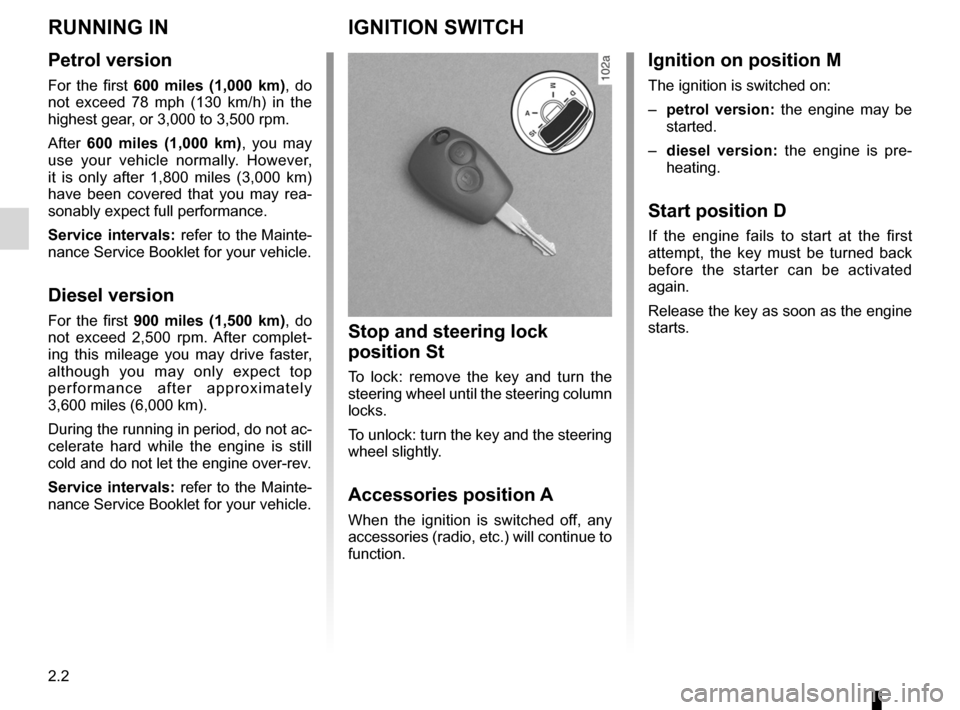
running in ...............................................................(current page)ignition switch ........................................................(current page)engine immobiliser (switch) ...................................(current page)driving ....................................................................(current page)starting ...................................................................(current page)
2.2
ENG_UD5481_1Rodage / Contacteur de démarrage (U90 - Dacia)ENG_NU_817-2_NU_Dacia_2
Rodage - Contacteur de démarrage
RUNNING IN
Petrol version
For the first 600 miles (1,000 km), do not exceed 78 mph (130 km/h) in the highest gear, or 3,000 to 3,500 rpm.
After 600 miles (1,000 km), you may use your vehicle normally. However, it is only after 1,800 miles (3,000 km) have been covered that you may rea- sonably expect full performance.
Service intervals: refer to the Mainte- nance Service Booklet for your vehicle.
Diesel version
For the first 900 miles (1,500 km), do not exceed 2,500 rpm. After complet- ing this mileage you may drive faster, although you may only expect top p e r f o r m a n c e a f t e r a p p r o x i m a t e l y 3,600 miles (6,000 km).
During the running in period, do not ac- celerate hard while the engine is still cold and do not let the engine over-rev.
Service intervals: refer to the Mainte- nance Service Booklet for your vehicle.
IGNITION SWITCH
Stop and steering lock
position St
To lock: remove the key and turn the steering wheel until the steering column locks.
To unlock: turn the key and the steering wheel slightly.
Accessories position A
When the ignition is switched off, any accessories (radio, etc.) will continue to function.
Ignition on position M
The ignition is switched on:
–
petrol version: the engine may be started.
–
diesel version: the engine is pre- heating.
Start position D
If the engine fails to start at the first attempt, the key must be turned back before the starter can be activated again.
Release the key as soon as the engine starts.
Page 61 of 146

driving ...................................................(up to the end of the DU)starting ..................................................(up to the end of the DU)starting the engine ................................(up to the end of the DU)
2.3
ENG_UD5482_1Mise en route / Arrêt du moteur (U90 - Dacia)ENG_NU_817-2_NU_Dacia_2
Stopping the engine
With the engine idling, turn the key back to “Stop” position St.
ÉDiesel injection
Turn the ignition key to ignition “On” po- sition M, and hold this position until the preheating warning light goes out.
Turn the key to starter position D with- out depressing the accelerator pedal.
Release the key as soon as the engine starts.
Starting the engine
Special feature on vehicles equipped with an engine immobiliser system
In very cold conditions (temperatures below –20°C): so that it is easier to start the engine, switch on the ignition for several seconds before starting the engine.
Make sure the engine immobiliser is not activated. Refer to the information on the “Engine immobiliser” in Section 1.
Petrol injection
Engine warm or cold
– Turn the key to the start position
without depressing the accelera- tor.
– Release the key as soon as the
engine starts.
Mise en route / Arrêt du moteur
STARTING/STOPPING THE ENGINE
Never leave your vehicle with the keys inside when leaving a child (or \
animal) in the car, even for a short period.
The reason for this is that the child may endanger himself or others by starting the engine, activating equipment such
as the window winders for example, or locking the doors.
Risk of serious injury.
Never switch off the ignition before the vehicle has stopped completely. Once the engine has stopped, the brake servo, power assisted steering and passive safety equipment such as air bags wi\
ll no longer operate.
The steering is locked when the key is removed.
Page 62 of 146
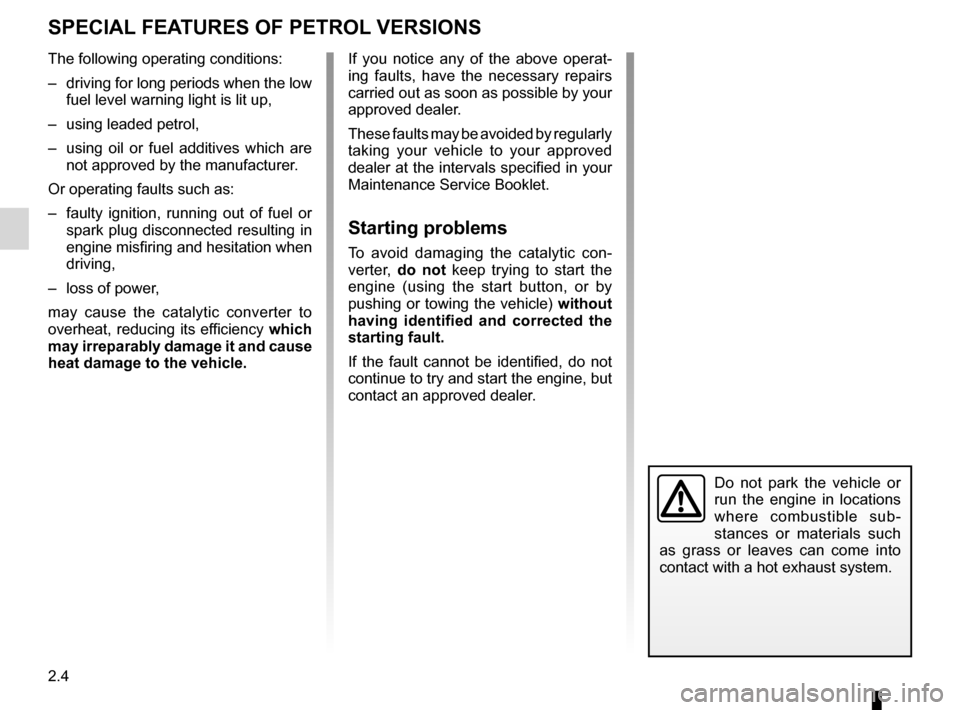
driving ...................................................(up to the end of the DU)catalytic converter.................................(up to the end of the DU)catalytic converter.................................(up to the end of the DU)special features of petrol vehicles ........(up to the end of the DU)
2.4
ENG_UD5483_1Particularités des versions essence (U90 - Dacia)ENG_NU_817-2_NU_Dacia_2
Particularités des versions essence
SPECIAL FEATURES OF PETROL VERSIONS
The following operating conditions:
– driving for long periods when the low
fuel level warning light is lit up,
– using leaded petrol,
– using oil or fuel additives which are
not approved by the manufacturer.
Or operating faults such as:
– faulty ignition, running out of fuel or
spark plug disconnected resulting in engine misfiring and hesitation when driving,
– loss of power,
may cause the catalytic converter to overheat, reducing its efficiency which may irreparably damage it and cause heat damage to the vehicle.
If you notice any of the above operat- ing faults, have the necessary repairs carried out as soon as possible by your approved dealer.
These faults may be avoided by regularly taking your vehicle to your approved dealer at the intervals specified in your Maintenance Service Booklet.
Starting problems
To avoid damaging the catalytic con- verter, do not keep trying to start the engine (using the start button, or by pushing or towing the vehicle) without having identified and corrected the starting fault.
If the fault cannot be identified, do not continue to try and start the engine, but contact an approved dealer.
Do not park the vehicle or
run the engine in locations where combustible sub- stances or materials such as grass or leaves can come into contact with a hot exhaust system.
Page 63 of 146
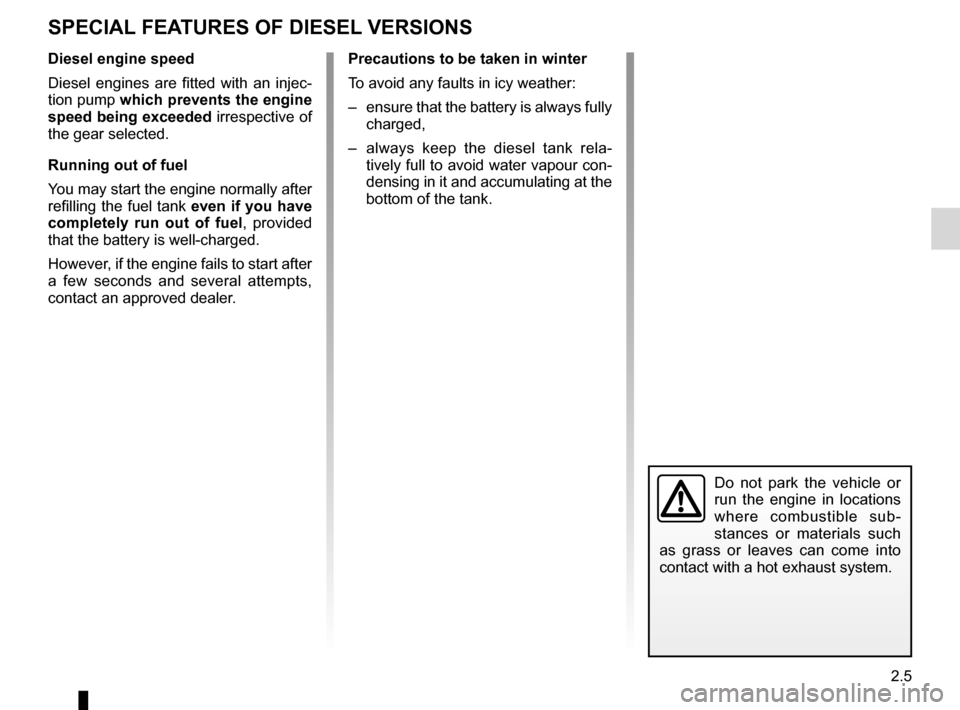
driving ...................................................(up to the end of the DU)special features of diesel versions........(up to the end of the DU)
2.5
ENG_UD5484_1Particularités des versions diesel (U90 - Dacia)ENG_NU_817-2_NU_Dacia_2
Particularités des versions diesel
SPECIAL FEATURES OF DIESEL VERSIONS
Diesel engine speed
Diesel engines are fitted with an injec- tion pump which prevents the engine speed being exceeded irrespective of the gear selected.
Running out of fuel
You may start the engine normally after refilling the fuel tank even if you have completely run out of fuel, provided that the battery is well-charged.
However, if the engine fails to start after a few seconds and several attempts, contact an approved dealer.
Precautions to be taken in winter
To avoid any faults in icy weather:
– ensure that the battery is always fully
charged,
– always keep the diesel tank rela
- tively full to avoid water vapour con- densing in it and accumulating at the bottom of the tank.
Do not park the vehicle or
run the engine in locations where combustible sub- stances or materials such as grass or leaves can come into contact with a hot exhaust system.
Page 64 of 146

antipollutionadvice .............................................(up to the end of the DU)fueladvice on fuel economy ..................(up to the end of the DU)driving ...................................................(up to the end of the DU)fuel economy ........................................(up to the end of the DU)
2.6
ENG_UD5485_1Conseils antipollution, économies de carburant, conduite (U90 - Daci\
a)ENG_NU_817-2_NU_Dacia_2
JauneNoirNoir texte
Conseils antipollution, économies de carburant
The manufacturer is acively striving to reduce pollutant exhaust gas emissions and to save energy.
By virtue of its design, moderate fuel consumption and initial settings, your vehicle conforms to current antipollu- tion regulations. Technical design, how- ever, cannot achieve all. The fuel con- sumption of your vehicle and the level of pollutant exhaust gas emissions are very much within your control. Make sure that your vehicle is maintained correctly, and is driven carefully.
Maintenance
It should be noted that failure to respect antipollution regulations may lead to legal action being taken against the vehicle owner. In addition, replacing engine, fuel supply system and exhaust components with parts other than those originally recommended by the manu- facturer may alter your vehicle so that it no longer complies with antipollution regulations.
Have your vehicle checked and ad- justed by your approved dealer in ac- cordance with the instructions in your Maintenance Service Booklet.
Your approved dealer has all the equipment necessary for ensuring that your vehicle is maintained to its original standard.
Engine adjustments
– ignition: this does not require ad- justment.
– spark plugs: for optimum fuel econ- omy, efficiency and performance the specifications laid down by our Design Department must be strictly applied.
If the spark plugs have to be changed, use the make, type and gap specified for your vehicle’s engine. Contact an approved Dealer as soon as possi- ble.
–
idle speed: this does not require ad- justment.
–
air filter, diesel filter: a choked el- ement hinders performance. It must be replaced.
ADVICE ON ANTIPOLLUTION, FUEL ECONOMY AND DRIVING
Page 65 of 146
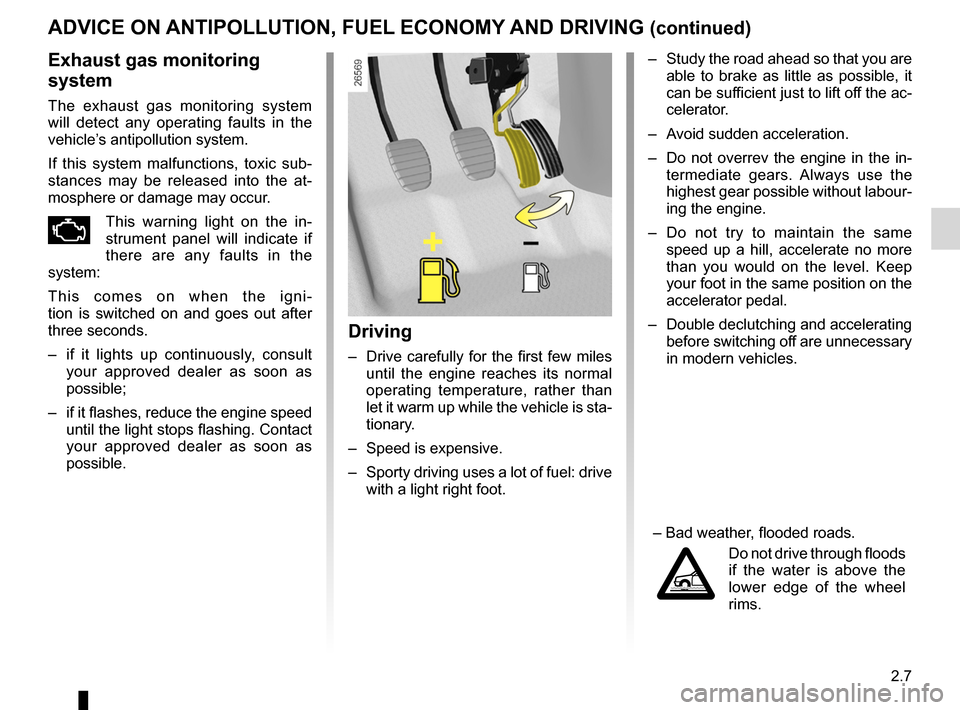
JauneNoirNoir texte
2.7
ENG_UD5485_1Conseils antipollution, économies de carburant, conduite (U90 - Daci\
a)ENG_NU_817-2_NU_Dacia_2
– Study the road ahead so that you are able to brake as little as possible, it can be sufficient just to lift off the ac- celerator.
– Avoid sudden acceleration.
– Do not overrev the engine in the in
- termediate gears. Always use the highest gear possible without labour- ing the engine.
– Do not try to maintain the same
speed up a hill, accelerate no more than you would on the level. Keep your foot in the same position on the accelerator pedal.
– Double declutching and accelerating
before switching off are unnecessary in modern vehicles.
– Bad weather, flooded roads.
Do not drive through floods if the water is above the lower edge of the wheel
rims.
Exhaust gas monitoring
system
The exhaust gas monitoring system will detect any operating faults in the vehicle’s antipollution system.
If this system malfunctions, toxic sub- stances may be released into the at- mosphere or damage may occur.
ÄThis warning light on the in- strument panel will indicate if there are any faults in the system:
T h i s c o m e s o n w h e n t h e i g n i- tion is switched on and goes out after three seconds.
– if it lights up continuously, consult
your approved dealer as soon as possible;
– if it flashes, reduce the engine speed
until the light stops flashing. Contact your approved dealer as soon as possible.
Driving
– Drive carefully for the first few miles until the engine reaches its normal operating temperature, rather than let it warm up while the vehicle is sta- tionary.
– Speed is expensive.
– Sporty driving uses a lot of fuel: drive
with a light right foot.
ADVICE ON ANTIPOLLUTION, FUEL ECONOMY AND DRIVING (continued)
Page 66 of 146

2.8
ENG_UD5485_1Conseils antipollution, économies de carburant, conduite (U90 - Daci\
a)ENG_NU_817-2_NU_Dacia_2
ADVICE ON ANTIPOLLUTION, FUEL ECONOMY AND DRIVING (continued)
– In vehicles fitted with air condi- tioning, it is normal to observe an increase in fuel consumption (es- pecially in city conditions) when it is used. For vehicles fitted with manual air conditioning, switch off the system when it is not required.
Some advice for reducing fuel consumption and therefore help- ing to protect the environment:
– It is advisable to drive with the air
vents open and the windows closed.
– If the vehicle has been parked in the
sun, open the doors for a few mo- ments to let the hot air escape before starting the engine.
– Never fill the fuel tank to the brim to
avoid overflow.
– Do not leave an empty roof rack
fitted to the vehicle.
– It is better to fit a trailer for bulky ob
- jects.
– When towing a caravan, fit a wind
deflector and adjust it carefully.
Advice on use
– Electricity is fuel; switch off all the electrical components which are not really needed.
However (safety first), keep your lights on when the visibility is bad (“see and be seen”).
– Use the air vents. Driving with the
windows open will increase fuel consumption by 4% at a speed of 60 mph (100 km/h). –
Avoid using the vehicle for door-to
- door journeys (short journeys, with long stops in-between) because in these conditions, the engine never reaches its ideal temperature.
Tyres
Increased fuel consumption could be the result of:
– insufficient pressure,
– using non-recommended tyres.
Page 78 of 146
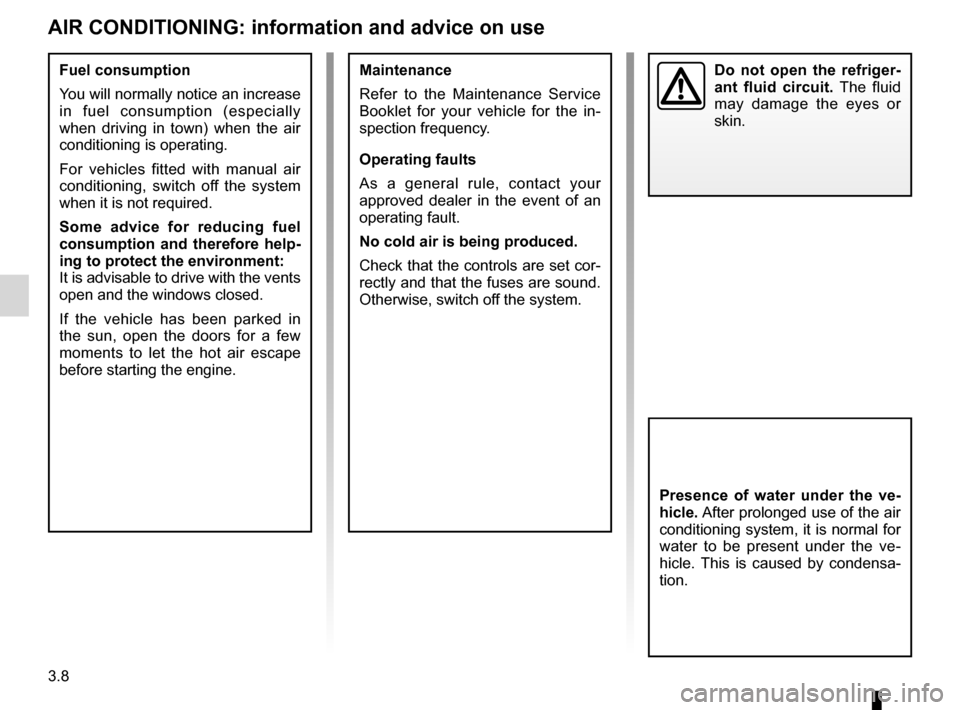
air conditioning .....................................(up to the end of the DU)heating system .....................................(up to the end of the DU)heating and air conditioning system .....(up to the end of the DU)ventilationheating and air conditioning system (up to the end of the DU)air conditioning ......................................................(current page)
3.8
ENG_UD5493_1Air conditionné : informations et conseils utilisation (U90 - Dacia)\
ENG_NU_817-2_NU_Dacia_3
AIR CONDITIONING: information and advice on use
Fuel consumption
You will normally notice an increase in fuel consumption (especially when driving in town) when the air conditioning is operating.
For vehicles fitted with manual air conditioning, switch off the system when it is not required.
Some advice for reducing fuel consumption and therefore help- ing to protect the environment:It is advisable to drive with the vents open and the windows closed.
If the vehicle has been parked in the sun, open the doors for a few moments to let the hot air escape before starting the engine.
Maintenance
Refer to the Maintenance Service Booklet for your vehicle for the in- spection frequency.
Operating faults
As a general rule, contact your approved dealer in the event of an operating fault.
No cold air is being produced.
Check that the controls are set cor- rectly and that the fuses are sound. Otherwise, switch off the system.
Do not open the refriger- ant fluid circuit. The fluid may damage the eyes or skin.
Presence of water under the ve- hicle. After prolonged use of the air conditioning system, it is normal for water to be present under the ve- hicle. This is caused by condensa- tion.